Related Research Articles

Rhynchospora is a genus of about 400 species of sedges with a cosmopolitan distribution. The genus includes both annual and perennial species, mostly with erect 3-sided stems and 3-ranked leaves. The achenes bear a beak-like tubercule and are sometimes subtended by bristles. Many of the species are similar in vegetative appearance, and mature fruits are needed to make a positive identification.

Aristida is a very nearly cosmopolitan genus of plants in the grass family. Aristida is distinguished by having three awns (bristles) on each lemma of each floret. The genus includes about 300 species found worldwide, often in arid warm regions. This genus is among those colloquially called three-awnswiregrasses, speargrasses and needlegrasses. The name Aristida is derived from the Latin "arista", meaning "awn".
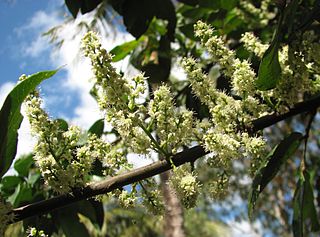
Guioa is a genus of about 78 rainforest tree species known to science, which constitute part of the plant family Sapindaceae. They have a wide distribution, ranging from throughout Malesia, in Burma, Cambodia, Vietnam, Thailand, Malay Peninsula, Borneo, Sumatra, Philippines, Java, Flores, Timor, Sulawesi, Moluccas, New Guinea, further southwards through the east coast of Queensland and New South Wales, Australia and further eastwards to the Pacific Islands, including Tonga, New Caledonia, Fiji and Samoa.
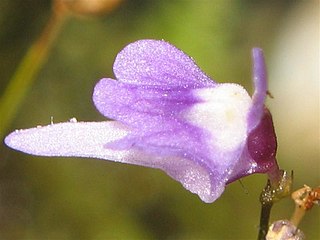
Utricularia minutissima is a small or very small terrestrial carnivorous plant that belongs to the genus Utricularia. U. minutissima is native to Asia and Australia. Among the islands of Southeast Asia, it is found on Borneo, New Guinea, and Sumatra.

Bay of Angra is a natural bay within the coastal extent of the municipality of Angra do Heroísmo, on the Portuguese island of Terceira in the archipelago of the Azores. Within an average depth of 40 metres (130 ft), the bay has been of historical importance to the island; since the 15th century, it was a port-of-call for returning merchant shipping from the East Indies and Brazil, laden with gold, silver, porcelain, spices, rare woods, and other goods. These ships would anchor in the Bay of Angra until supported by armed escorts, which would accompany the ships on the rest of their voyage to Portugal. The Bay at Angra provided shelter from northern and northwestern winds; only storms originating to the south or southeast, posed a threat. Nonetheless, the Bay is the final resting-place of several ships affected by the adverse winds: local archives and a rich oral tradition supports the foundering of many ships against the leeward shore.

Schlechtendalia is a genus of South American plants in the Barnadesieae within the daisy family. It is known in Portuguese as bolão de ouro, meaning "gold bullion". It is a perennial herbaceous plant, with rigid, linear leaves with a pointy tip. The corollas of the florets are yellow, and of the subbilobiate type, with four lobes merged into a strap, but split into teeth over half as deep, and one lobe free. This species flowers from September to December and the fruits are ripe in January or February. The only known species is Schlechtendalia luzulifolia, native to southern Brazil, Uruguay, northern Argentina. This species has sixteen chromosomes (2n=16).

The marine snail Norrisia norrisii is a medium-sized gastropod mollusk within the family Tegulidae. It has several common names, including Norris's top snail, Norris's topsnail, norrissnail, smooth brown turban snail, or kelp snail. It was first described by G.B. Sowerby I under the name Trochiscus norrisii.
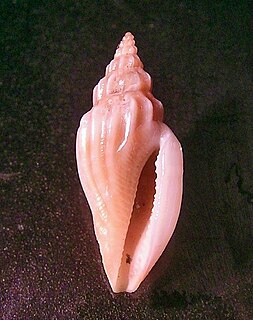
Eucithara is a genus of small to quite large sea snails, marine gastropod mollusks in the family Mangeliidae.
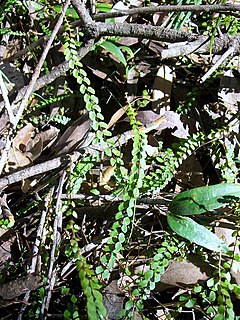
Lindsaea, common name necklace fern, is a genus of around 180 species of fern, 15 of which reach Australia. The name is in honour of surgeon John Lindsay of Jamaica. The genus is sometimes spelt Lindsaya.

Cythara is a genus of sea snails, marine gastropod mollusks in the family Mangeliidae.
Iarucanga is a genus of longhorn beetles of the subfamily Lamiinae, containing the following species:

Carex capillacea, common name yellowleaf sedge in Tasmania, is a species of sedge found in Assam, the far east of Russia, New Guinea, south east Australia, New Zealand, Malesia, China, Japan and India.

Rhynchospora capillacea is a species of sedge known by the common names needle beaksedge, slender beakrush and needle beakrush. It is native to eastern North America from Labrador to Alberta, and south to Texas. It grows in wet, usually calcareous habitat, such as fens, sandy or stony shores, interdunal flats, and wet meadows It is a perennial herb producing clumps of stems 10 to 40 centimeters tall, each stem with very narrow, filiform leaves. The inflorescence consists of few (1-4) narrow brown spikelets each about 6 or 7 millimeters long.
Pythium porphyrae, is a parasitic species of oomycete in the family Pythiaceae. It is the cause of red rot disease or red wasting disease, also called akagusare (赤ぐされ) in Japanese. The specific epithet porphyrae (πορφυρα) stems from the genus of one of its common hosts, Porphyra, and the purple-red color of the lesions on the thallus of the host. However, many of its hosts have been moved from the genus Porphyra to Pyropia.
Utricularia capillacea is a species of carnivorous plant from the Lentibulariaceae family, Lamiales order, described by Carl Ludwig Willdenow. According to the Catalogue of Life sUtricularia capillacea does not have known subspecies.
Aristida capillacea is a species of plants in the grass family (Poaceae). It is found in South America.
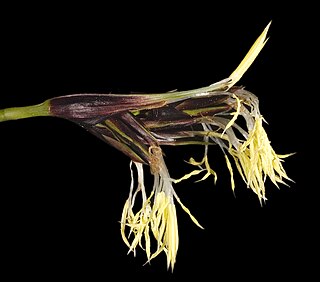
Tetraria is a genus of flowering plants in the sedge family, Cyperaceae, native to Tanzania, South Africa, Borneo, Australia and New Zealand.
References
- ↑ BioLib.cz - Iarucanga capillacea. Retrieved on 8 September 2014.
| This Hemilophini article is a stub. You can help Wikipedia by expanding it. |